![]()
![]()
![]()
Use LEFT and RIGHT arrow keys to navigate between flashcards;
Use UP and DOWN arrow keys to flip the card;
H to show hint;
A reads text to speech;
65 Cards in this Set
- Front
- Back
- 3rd side (hint)
|
What cells are specialized for electrical signaling over long distances?
|
Nerve cells, or neurons.
|
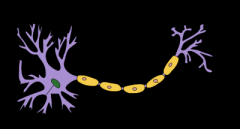
These cells are also specialized for intercellular communication.
|
|
|
What cells provide support and protection for neurons in the brain, and for neurons in other parts of the nervous system?
|
Neuroglia, or glia.
|
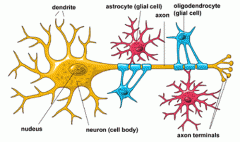
These cells are not capable of significant electrical signaling.
|
|
|
What specific area of the neuron are the primary target for synaptic input from other neurons?
|
Dendrites.
|
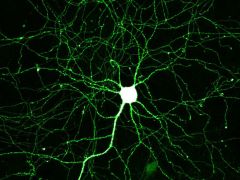
This area of the neuron branches out into a structure that is known as a dendritic tree.
|
|
|
The number of inputs to a single neuron reflects the degree of...
|
...convergence.
|
|
|
|
The number of targets innervated by any one neuron represents its...
|
...divergence.
|
|
|
|
What is the space between neurons at a nerve synapse across which a nerve impulse is transmitted by a neurotransmitter?
|
Synaptic cleft.
|
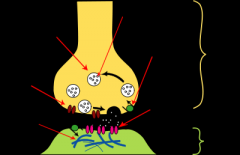
This area is not simply empty space, it is the site extracellular proteins that influence the diffusion, binding, and degradation of molecules secreted by the presynaptic terminal.
|
|
|
What is the region of the neuron conducting signals towards the synapse?
|
Presynaptic terminal, synaptic ending, axon terminal, or terminal boutons
|
The distal terminations of axons which are specialized for the release of neurotransmitters.
|
|
|
A unique extension from the soma that may travel a few hundred micrometers (microns) or much farther depending on the size of the species.
|
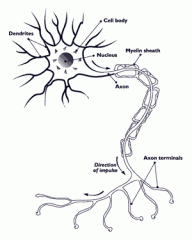
What is an axon?
|
This typically conducts electrical impulses away from the soma, the function is to transmit information to different neurons, muscles and glands
|
|
|
What is the term used to describe relatively short axons that only connect with nearby neurons?
|
Local circuit neurons or interneurons.
|
These neurons are distinguish from the axons of projection neurons, whose axons (projection fibers) project to more distant regions of the brain or spinal cord.
|
|
|
The axons of what neurons extend to distant targets?
|
Projections neurons.
|
The neurons run that from the human spinal cord to the foot are about a meter long.
|
|
|
What is the event that carries signals over the axons of neurons?
|
Action potential.
|
This event is a self-regenerating wave of electrical activity that propagates from the axon hillock (located in the soma) to the terminus of the axon, at which point synapses are made.
|
|
|
What is the chemical and eletrical process by which the information encoded by action potentials is passed on at synaptic contacts to the next cell pathway called?
|
Synaptic transmission.
|
|
|
|
What is the most abundant type of synapse in the nervous system?
|
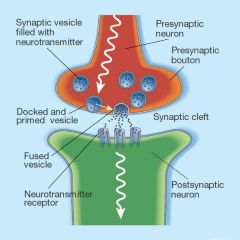
Chemical synapse.
|
The synaptic vesicles in this case are filled with neurotransmitter molecules, these neurotransmitters modify the electrical properties of the target cell.
|
|
|
What part of the neuron recieves neurotransmitters released from synaptic vesicles?
|
Neurotransmitter receptor or neuroreceptor.
|
|
|
|
What term is used to refer to the component of a synapse specialized for transmitter reception?
|
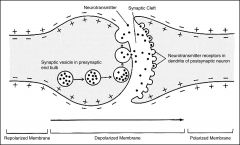
Postsynaptic.
|
Downstream at a synapse.
|
|
|
What are the three types of glial cells in the mature central nervous system?
|
Astrocytes, oligodendrocytes, and microglial cells.
|
|
|

Restricted to the CNS, have elaborate local processes that give these cells a starlike appearance, maintain chemical environment for neuronal signaling. What glia cell am I?
|
Astrocytes or collectively astroglia.
|
This glia cell is twenty times larger in human brains incomparison to rodent brains. A single human ________ encompasses 2 million synapses compared to 100,000 in rodents. A team of neuroscientists has grafted these human brain cells into the brains of mice and found that the rodents’ rate of learning and memory far surpassed that of ordinary mice.
|
|
|
Restricted to the CNS, lay down a laminated, lipid-rich wrapping called myelin around some, but not all axons. What glia cell am I?
|
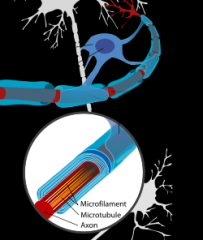
Oligodendrocytes.
|
|
|
|
Primarily derived from hematopoietic precursor cells, remove cellular debris from site of injury or normal cell turnover, secrete signaling molecules. What glia cell am I?
|
Microglial cell.
|
|
|
|
Neurons are organized into ensembles that process specific kinds of information and provide the foundation of sensation, perception, and behavior.
|
What are neural circuits?
|
|
|
|
The dense tangle of axonal and dendritic branches, and the synapses between them, that lies between neuronal cell bodies in the gray matter of the brain and spinal cord.
|
What is neurophil?
|
The regions between nerve cell bodies where most synaptic connectivity occurs.
|
|
|
Nerve cells that carry information from the periphery toward the brain.
|
What are afferent neurons?
|
|
|
|
Nerve cells that carry information away from the brain or spinal cord (or away from the circuit in question).
|
What are efferent neurons?
|
|
|
|
What constitutes the basics of all neural circuits?
|
Afferent neurons, efferent neurons, and interneurons.
|
|
|
|
A fundamental spinal reflex that is generated by the motor response to afferent sensory information arising from muscle spindles.
|
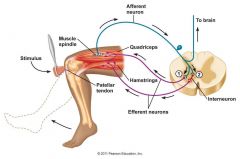
What is the myotatic spinal reflex?
|
|
|
|
A nodule on a dorsal root of the spine that contains cell bodies of neurons that carry signals from sensory organs toward the appropriate integration center, the first-order neurons of the dorsal column medial lemniscus pathway.
|
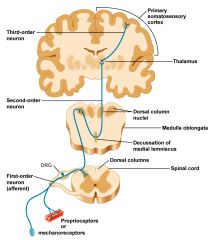
What is a dorsal root ganglion?
|
In the peripheral nervous system, afferents refer to the axons that relay sensory information into the central nervous system (i.e. the brain and the spinal cord).
|
|
|
A structure containing a number of nerve cell bodies.
|
What is a ganglion (plural: ganglia)?
|
|
|
|
The 12 pairs of nerves arising from the brainstem that carry sensory information toward (and sometimes motor information away from) the CNS.
|
What are cranial nerves?
|
|
|
|
What is the term applied to neurons located in the CNS that project their axons outside the CNS and directly or indirectly control muscles?
|
Motor neurons.
|
These are efferant neurons that carry signals from the spinal cord to the muscles to produce movement.
|
|
|
An electrode is placed near the neuron of interest to detect its activity.
|
What is an extracellular recording?
|
This type of recording primarily detects actions potentials, the all-or-nothing changes in the potential (voltage) across nerve cell membranes that convey information from one point to another in the nervous system.
|
|
|
An electrode is placed inside the cell.
|
What is an intracellular recording?
|
This type of recording can detect the smaller, graded potential changes that trigger action potentials, and thus allow a more detailed analysis of communication between neurons within a circuit.
|
|
|
The difference in electrical potential between the interior and the exterior of a biological cell.
|
What is the membrane potential (also transmembrane potential or membrane voltage)?
|
Typical values range from –40 mV to –80 mV.
|
|
|
A type of graded potential, the membrane potential difference of a sensory receptor.
|
What is a receptor potential?
|
A graded potential that triggers actions potential and arises at the sensory receptor.
|
|
|
Graded potential changes that trigger action potentials at the synapse.
|
What is a synaptic potential?
|
|
|
|
Circuits that process similar types of information and serve broader behavioral purposes.
|
What are neural systems?
|
Example: sensory systems, motor systems, etc.
|
|
|
Neural systems that acquire and process information from the environment.
|
What are sensory systems?
|
e.g., the visual system or the auditory system
|
|
|
Neural systems that respond to sensory information by generating movements and other behavior,
|
What are motor systems?
|
|
|
|
A large number of cells and circuits that lie between well-defined input and output systems.
|
What are associational systems?
|
These systems mediate the most complex and least well-characterized brain functions.
|
|
|
What is the CNS?
|
The central nervous system, compromises the brain and the spinal cord.
|
|
|
|
One of the two regions of the vertebrate brain that are delineated by the median plane.
|
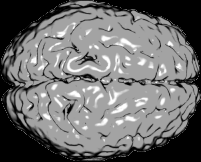
What is a cerebral hemisphere?
|
The brain can thus be described as being divided into left and right ________ ___________.
|
|
|
The "interbrain" is the region of the vertebrate neural tube which gives rise to posterior forebrain structures.
|
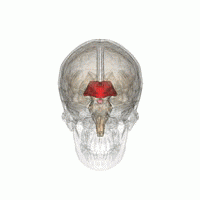
What is the diencephalon?
|
|
|
|
A region of the brain that plays an important role in motor control and has the appearance of a separate structure attached to the bottom of the brain, tucked underneath the cerebral hemispheres.
|
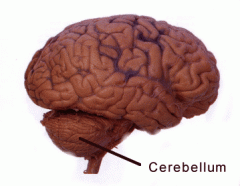
What the cerebellum?
|
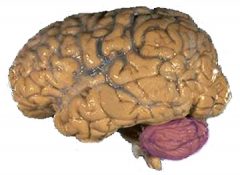
Latin for little brain.
|
|
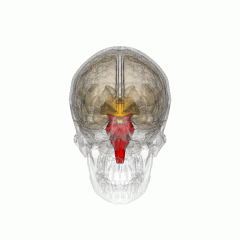
The posterior part of the brain, adjoining and structurally continuous with the spinal cord. It provides the main motor and sensory innervation to the face and neck via the cranial nerves.
|
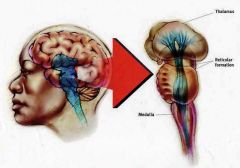
What is the brain stem?
|
Regulates the central nervous system, and is pivotal in maintaining consciousness and regulating the sleep cycle
|
|
|
What is the PNS?
|
The peripheral nervous system.
|
This includes the sensory neurons that link sensory receptors on the body surface or deeper within it with relevant processing circuits in the central nervous system.
|
|
|
What are the two motor portions of the PNS?
|
The somatic motor division and the visceral or autonomic motor division.
|
|
|
|
The motor axons that connect the the brain and spinal cord to skeletal muscles.
|
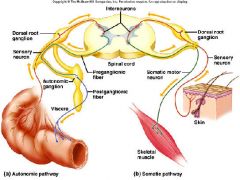
What is the somatic motor division?
|
|
|
|
The cells and axons that innevate smooth muscles, cardiac muscle, and glands.
|
What is the visceral or autonomic motor division?
|
|
|
|
The glia cells of the peripheral nervous system.
|
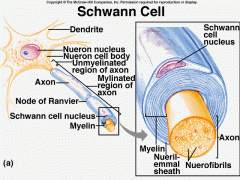
What are Schwann cells?
|
|
|
|
Refers to accumlation of cell bodies and neurophil in the brain and spinal cord (e.g., nuclie or cortices)
|
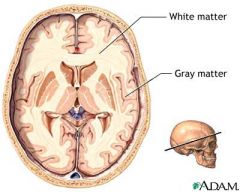
What is gray matter?
|
|
|
|
Refers tp axon tacts and commissures.
|
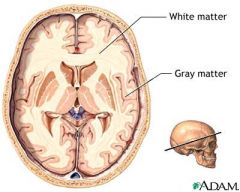
What is white matter?
|
Named for its relatively light appearance, the result of the lipid content myelin.
|
|
|
The neuronal axons that are grouped together to form a pathway; a serial arrangement that serves a common function.
|
What are tracts?
|
|
|
|
Tracts that cross the midline of the brain are referred to as what?
|
Commissures.
|
A line or place at which two things are joined.
|
|
|
The part of the autonomic nervous system originating in the thoracic and lumbar regions of the spinal cord. Its funtions include reduce digestive secretions, speeding up the heart, and contracting blood vessels.
|
What is the sympathetic division of the autonomic motor system?
|
Behaves complementary to the physiological effects of the parasympathetic nervous system.
|
|
|
Originates in the brain stem and lower part of the spinal cord; stimulates digestive secretions; slows the heart; constricts the pupils; dilates blood vessels
|
What is the parasympathetic nervous system?
|
Opposes physiological effects of the sympathetic nervous system.
|
|
|
One of three parts of the autonomic nervous system, is made up of small ganglia as well as individual neurons scattered throughout the wall of the gut. It can and does operate independently of the brain and the spinal cord.
|
What is the enteric system?
|
The esophagus, stomach, small and large intestines are lined with sheaths of tissue containing neurons that are "soaked" in the same neurotransmitters that exist in the brain and are influenced by them.
|
|
|
Much of neuroscience rests upon observations made by purposefully damaging a distinct brain region, nerve, or tract in an experimental animal and observing and documenting the subsequent loss of function.
|
What are lesion studies?
|
|
|
|
A research method which is used to trace axonal projections from their source (the cell body or soma) to their point of termination (the synapse).
|
What is anterograde tracing?
|
|
|
|
A research method which is used in neuroscience to trace neural connections from their point of termination (the synapse) to their source (the cell body).
|
What is retrograde tracing?
|
|
|
|
What is an action potential?
|
The electrical signal conducted along axons (or muscle fibers) by which information in conveyed from one place to another in the nervous system.
|
|
|
|
The sensory ganglia associated with the cranial nerves; these correspond to the dorsal root ganglia of the spinal segmental nerves.
|
What is cranial nerve ganglia?
|
|
|
|
The bundle of axons that runs from the dorsal root ganglia to the dorsal horn of the spinal cord, carrying sensory information from the periphery.
|
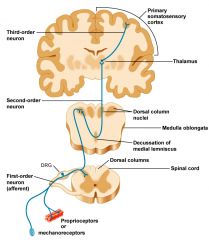
What are dorsal roots?
|
|
|
|
What term is used referring to the back?
|
Dorsal.
|
|
|
|
Major ascending tracts in the spinal cord that carry mechenosensory information from the first-order sensory neurons in dorsal root ganglia to the dorsal column nuclei; also called the posterior funiculi.
|
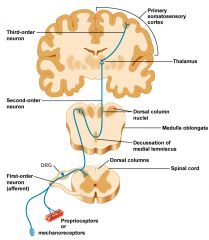
What are dorsal columns?
|
|
|
|
Second-order sensory neurons in the lower medulla that relay mechanosensory information from the spinal cord to the thalamus; comprises the cuneate and gracile nuclei.
|
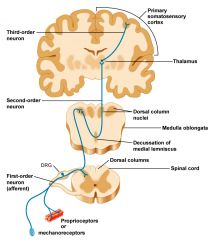
What are dorsal column nuclei?
|
|
|
|
The sensory pathway responsible for transmitting fine touch, vibration and conscious proprioceptive information from the body to the cerebral cortex.
|
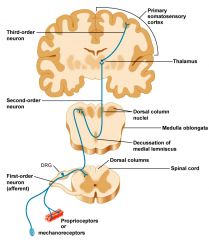
What is the dorsal column-medial lemniscus pathway?
|
|

